Introduction to Financial Accounting: Ethical Decision-Making Models
VerifiedAdded on 2023/06/12
|6
|1382
|146
Report
AI Summary
This report provides an overview of ethical principles in financial accounting, focusing on autonomy, beneficence, non-maleficence, and justice. It examines ethical decision-making models, particularly the PLUS model and character-based model, and identifies stakeholders affected by ethical issues within a company scenario involving harmful chocolates and a lawsuit. The report critiques the Chief Financial Officer's actions regarding the non-disclosure of the incident, highlighting violations of ethical principles and recommending that the company address the issue responsibly, compensate the affected customer if proven liable, and implement measures to prevent future harm. The analysis emphasizes the importance of ethical reasoning over personal gain and reputation protection in financial reporting.
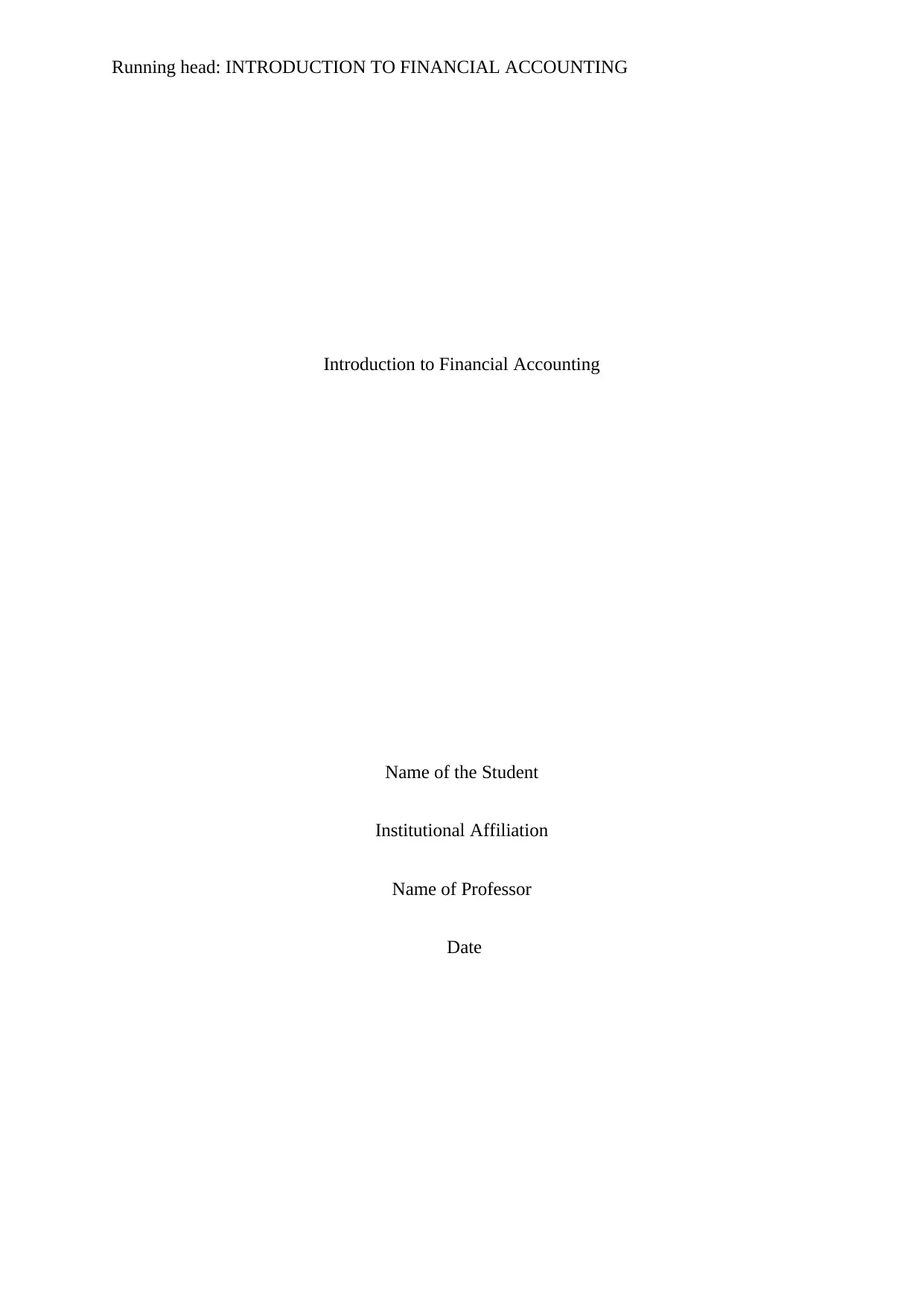
Running head: INTRODUCTION TO FINANCIAL ACCOUNTING
Introduction to Financial Accounting
Name of the Student
Institutional Affiliation
Name of Professor
Date
Introduction to Financial Accounting
Name of the Student
Institutional Affiliation
Name of Professor
Date
Paraphrase This Document
Need a fresh take? Get an instant paraphrase of this document with our AI Paraphraser
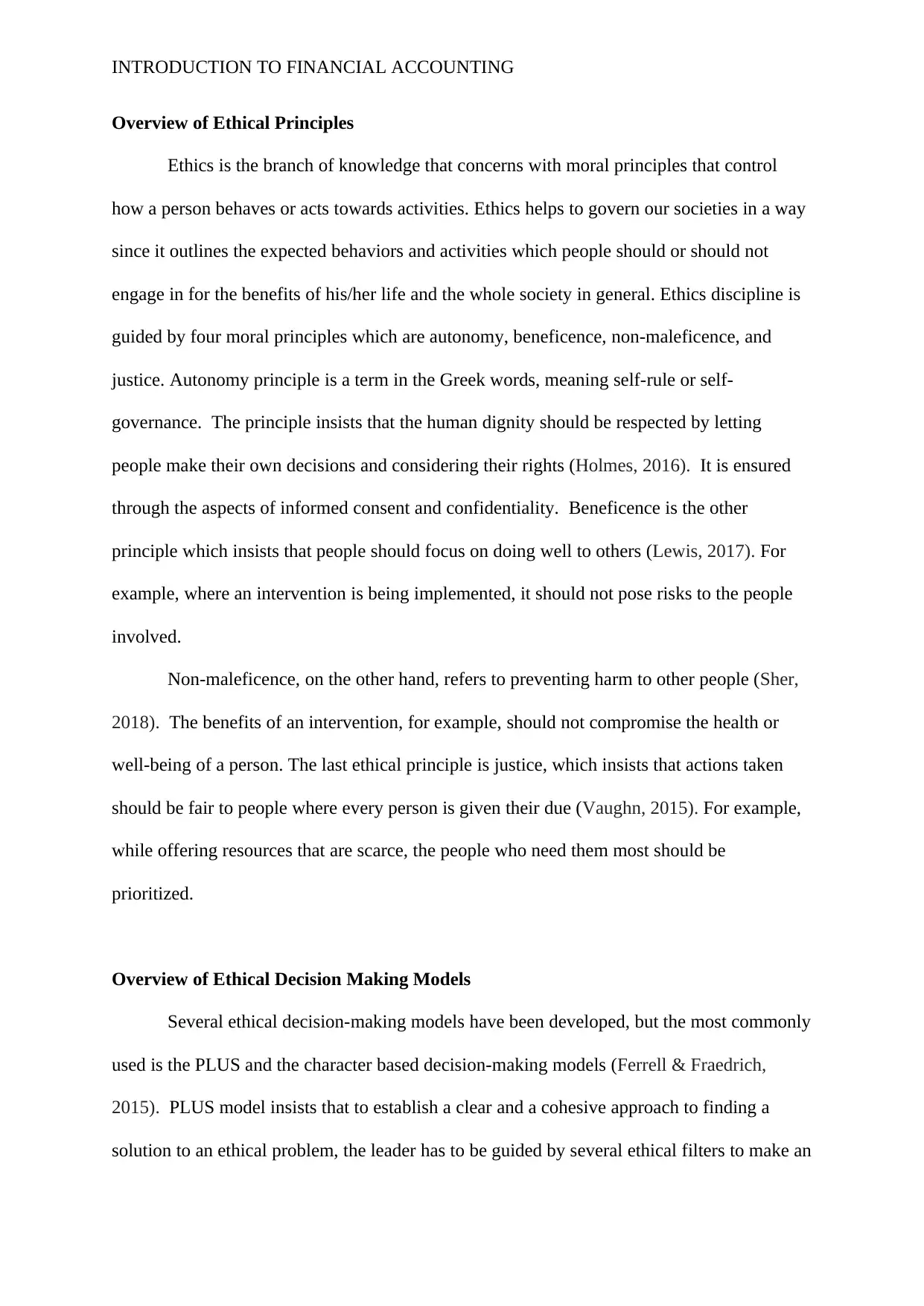
INTRODUCTION TO FINANCIAL ACCOUNTING
Overview of Ethical Principles
Ethics is the branch of knowledge that concerns with moral principles that control
how a person behaves or acts towards activities. Ethics helps to govern our societies in a way
since it outlines the expected behaviors and activities which people should or should not
engage in for the benefits of his/her life and the whole society in general. Ethics discipline is
guided by four moral principles which are autonomy, beneficence, non-maleficence, and
justice. Autonomy principle is a term in the Greek words, meaning self-rule or self-
governance. The principle insists that the human dignity should be respected by letting
people make their own decisions and considering their rights (Holmes, 2016). It is ensured
through the aspects of informed consent and confidentiality. Beneficence is the other
principle which insists that people should focus on doing well to others (Lewis, 2017). For
example, where an intervention is being implemented, it should not pose risks to the people
involved.
Non-maleficence, on the other hand, refers to preventing harm to other people (Sher,
2018). The benefits of an intervention, for example, should not compromise the health or
well-being of a person. The last ethical principle is justice, which insists that actions taken
should be fair to people where every person is given their due (Vaughn, 2015). For example,
while offering resources that are scarce, the people who need them most should be
prioritized.
Overview of Ethical Decision Making Models
Several ethical decision-making models have been developed, but the most commonly
used is the PLUS and the character based decision-making models (Ferrell & Fraedrich,
2015). PLUS model insists that to establish a clear and a cohesive approach to finding a
solution to an ethical problem, the leader has to be guided by several ethical filters to make an
Overview of Ethical Principles
Ethics is the branch of knowledge that concerns with moral principles that control
how a person behaves or acts towards activities. Ethics helps to govern our societies in a way
since it outlines the expected behaviors and activities which people should or should not
engage in for the benefits of his/her life and the whole society in general. Ethics discipline is
guided by four moral principles which are autonomy, beneficence, non-maleficence, and
justice. Autonomy principle is a term in the Greek words, meaning self-rule or self-
governance. The principle insists that the human dignity should be respected by letting
people make their own decisions and considering their rights (Holmes, 2016). It is ensured
through the aspects of informed consent and confidentiality. Beneficence is the other
principle which insists that people should focus on doing well to others (Lewis, 2017). For
example, where an intervention is being implemented, it should not pose risks to the people
involved.
Non-maleficence, on the other hand, refers to preventing harm to other people (Sher,
2018). The benefits of an intervention, for example, should not compromise the health or
well-being of a person. The last ethical principle is justice, which insists that actions taken
should be fair to people where every person is given their due (Vaughn, 2015). For example,
while offering resources that are scarce, the people who need them most should be
prioritized.
Overview of Ethical Decision Making Models
Several ethical decision-making models have been developed, but the most commonly
used is the PLUS and the character based decision-making models (Ferrell & Fraedrich,
2015). PLUS model insists that to establish a clear and a cohesive approach to finding a
solution to an ethical problem, the leader has to be guided by several ethical filters to make an
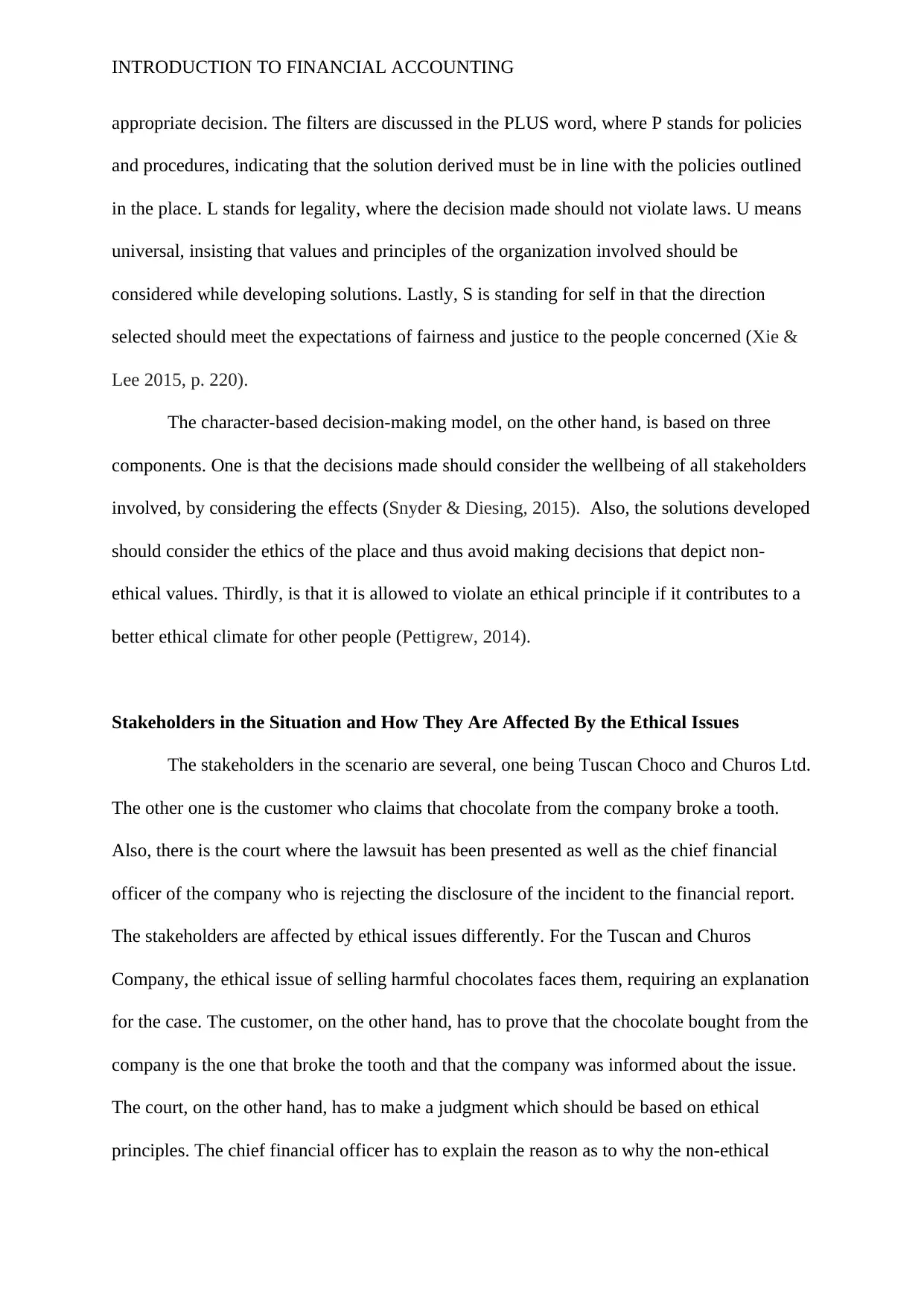
INTRODUCTION TO FINANCIAL ACCOUNTING
appropriate decision. The filters are discussed in the PLUS word, where P stands for policies
and procedures, indicating that the solution derived must be in line with the policies outlined
in the place. L stands for legality, where the decision made should not violate laws. U means
universal, insisting that values and principles of the organization involved should be
considered while developing solutions. Lastly, S is standing for self in that the direction
selected should meet the expectations of fairness and justice to the people concerned (Xie &
Lee 2015, p. 220).
The character-based decision-making model, on the other hand, is based on three
components. One is that the decisions made should consider the wellbeing of all stakeholders
involved, by considering the effects (Snyder & Diesing, 2015). Also, the solutions developed
should consider the ethics of the place and thus avoid making decisions that depict non-
ethical values. Thirdly, is that it is allowed to violate an ethical principle if it contributes to a
better ethical climate for other people (Pettigrew, 2014).
Stakeholders in the Situation and How They Are Affected By the Ethical Issues
The stakeholders in the scenario are several, one being Tuscan Choco and Churos Ltd.
The other one is the customer who claims that chocolate from the company broke a tooth.
Also, there is the court where the lawsuit has been presented as well as the chief financial
officer of the company who is rejecting the disclosure of the incident to the financial report.
The stakeholders are affected by ethical issues differently. For the Tuscan and Churos
Company, the ethical issue of selling harmful chocolates faces them, requiring an explanation
for the case. The customer, on the other hand, has to prove that the chocolate bought from the
company is the one that broke the tooth and that the company was informed about the issue.
The court, on the other hand, has to make a judgment which should be based on ethical
principles. The chief financial officer has to explain the reason as to why the non-ethical
appropriate decision. The filters are discussed in the PLUS word, where P stands for policies
and procedures, indicating that the solution derived must be in line with the policies outlined
in the place. L stands for legality, where the decision made should not violate laws. U means
universal, insisting that values and principles of the organization involved should be
considered while developing solutions. Lastly, S is standing for self in that the direction
selected should meet the expectations of fairness and justice to the people concerned (Xie &
Lee 2015, p. 220).
The character-based decision-making model, on the other hand, is based on three
components. One is that the decisions made should consider the wellbeing of all stakeholders
involved, by considering the effects (Snyder & Diesing, 2015). Also, the solutions developed
should consider the ethics of the place and thus avoid making decisions that depict non-
ethical values. Thirdly, is that it is allowed to violate an ethical principle if it contributes to a
better ethical climate for other people (Pettigrew, 2014).
Stakeholders in the Situation and How They Are Affected By the Ethical Issues
The stakeholders in the scenario are several, one being Tuscan Choco and Churos Ltd.
The other one is the customer who claims that chocolate from the company broke a tooth.
Also, there is the court where the lawsuit has been presented as well as the chief financial
officer of the company who is rejecting the disclosure of the incident to the financial report.
The stakeholders are affected by ethical issues differently. For the Tuscan and Churos
Company, the ethical issue of selling harmful chocolates faces them, requiring an explanation
for the case. The customer, on the other hand, has to prove that the chocolate bought from the
company is the one that broke the tooth and that the company was informed about the issue.
The court, on the other hand, has to make a judgment which should be based on ethical
principles. The chief financial officer has to explain the reason as to why the non-ethical
⊘ This is a preview!⊘
Do you want full access?
Subscribe today to unlock all pages.

Trusted by 1+ million students worldwide
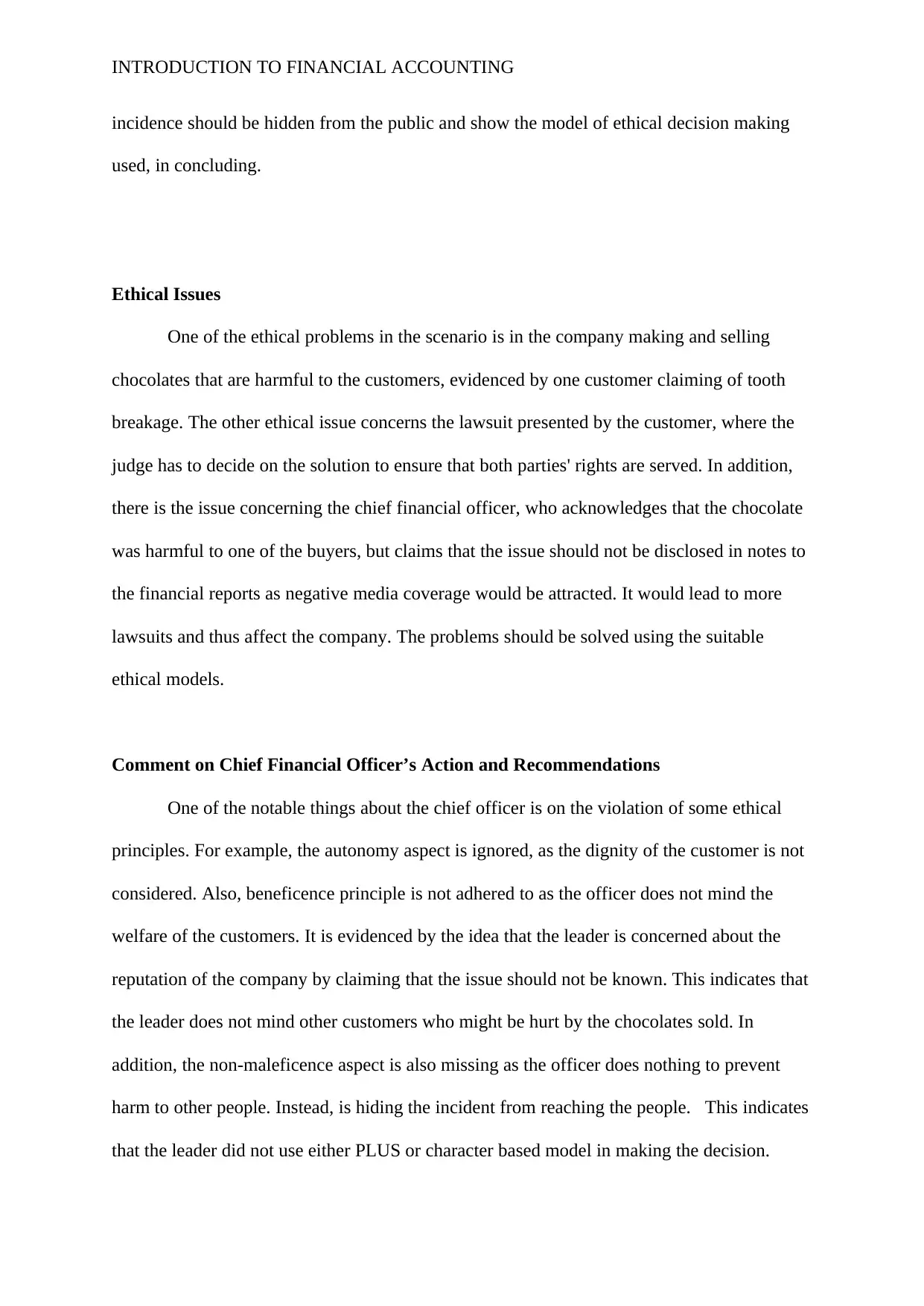
INTRODUCTION TO FINANCIAL ACCOUNTING
incidence should be hidden from the public and show the model of ethical decision making
used, in concluding.
Ethical Issues
One of the ethical problems in the scenario is in the company making and selling
chocolates that are harmful to the customers, evidenced by one customer claiming of tooth
breakage. The other ethical issue concerns the lawsuit presented by the customer, where the
judge has to decide on the solution to ensure that both parties' rights are served. In addition,
there is the issue concerning the chief financial officer, who acknowledges that the chocolate
was harmful to one of the buyers, but claims that the issue should not be disclosed in notes to
the financial reports as negative media coverage would be attracted. It would lead to more
lawsuits and thus affect the company. The problems should be solved using the suitable
ethical models.
Comment on Chief Financial Officer’s Action and Recommendations
One of the notable things about the chief officer is on the violation of some ethical
principles. For example, the autonomy aspect is ignored, as the dignity of the customer is not
considered. Also, beneficence principle is not adhered to as the officer does not mind the
welfare of the customers. It is evidenced by the idea that the leader is concerned about the
reputation of the company by claiming that the issue should not be known. This indicates that
the leader does not mind other customers who might be hurt by the chocolates sold. In
addition, the non-maleficence aspect is also missing as the officer does nothing to prevent
harm to other people. Instead, is hiding the incident from reaching the people. This indicates
that the leader did not use either PLUS or character based model in making the decision.
incidence should be hidden from the public and show the model of ethical decision making
used, in concluding.
Ethical Issues
One of the ethical problems in the scenario is in the company making and selling
chocolates that are harmful to the customers, evidenced by one customer claiming of tooth
breakage. The other ethical issue concerns the lawsuit presented by the customer, where the
judge has to decide on the solution to ensure that both parties' rights are served. In addition,
there is the issue concerning the chief financial officer, who acknowledges that the chocolate
was harmful to one of the buyers, but claims that the issue should not be disclosed in notes to
the financial reports as negative media coverage would be attracted. It would lead to more
lawsuits and thus affect the company. The problems should be solved using the suitable
ethical models.
Comment on Chief Financial Officer’s Action and Recommendations
One of the notable things about the chief officer is on the violation of some ethical
principles. For example, the autonomy aspect is ignored, as the dignity of the customer is not
considered. Also, beneficence principle is not adhered to as the officer does not mind the
welfare of the customers. It is evidenced by the idea that the leader is concerned about the
reputation of the company by claiming that the issue should not be known. This indicates that
the leader does not mind other customers who might be hurt by the chocolates sold. In
addition, the non-maleficence aspect is also missing as the officer does nothing to prevent
harm to other people. Instead, is hiding the incident from reaching the people. This indicates
that the leader did not use either PLUS or character based model in making the decision.
Paraphrase This Document
Need a fresh take? Get an instant paraphrase of this document with our AI Paraphraser

INTRODUCTION TO FINANCIAL ACCOUNTING
Instead, personal gains and reputation protection were considered, which depicts unethical
reasoning.
One of the recommendations concerning the scenario is that the company should
address the issue, by ensuring that the goods sold to customers are not harmful. Also, if the
customer proves that the chocolate from the company leads to tooth damage, the company
should take responsibility in compensating the client and sending an apology message to the
buyers of the company as well describe plans developed in rectifying the issue.
Instead, personal gains and reputation protection were considered, which depicts unethical
reasoning.
One of the recommendations concerning the scenario is that the company should
address the issue, by ensuring that the goods sold to customers are not harmful. Also, if the
customer proves that the chocolate from the company leads to tooth damage, the company
should take responsibility in compensating the client and sending an apology message to the
buyers of the company as well describe plans developed in rectifying the issue.
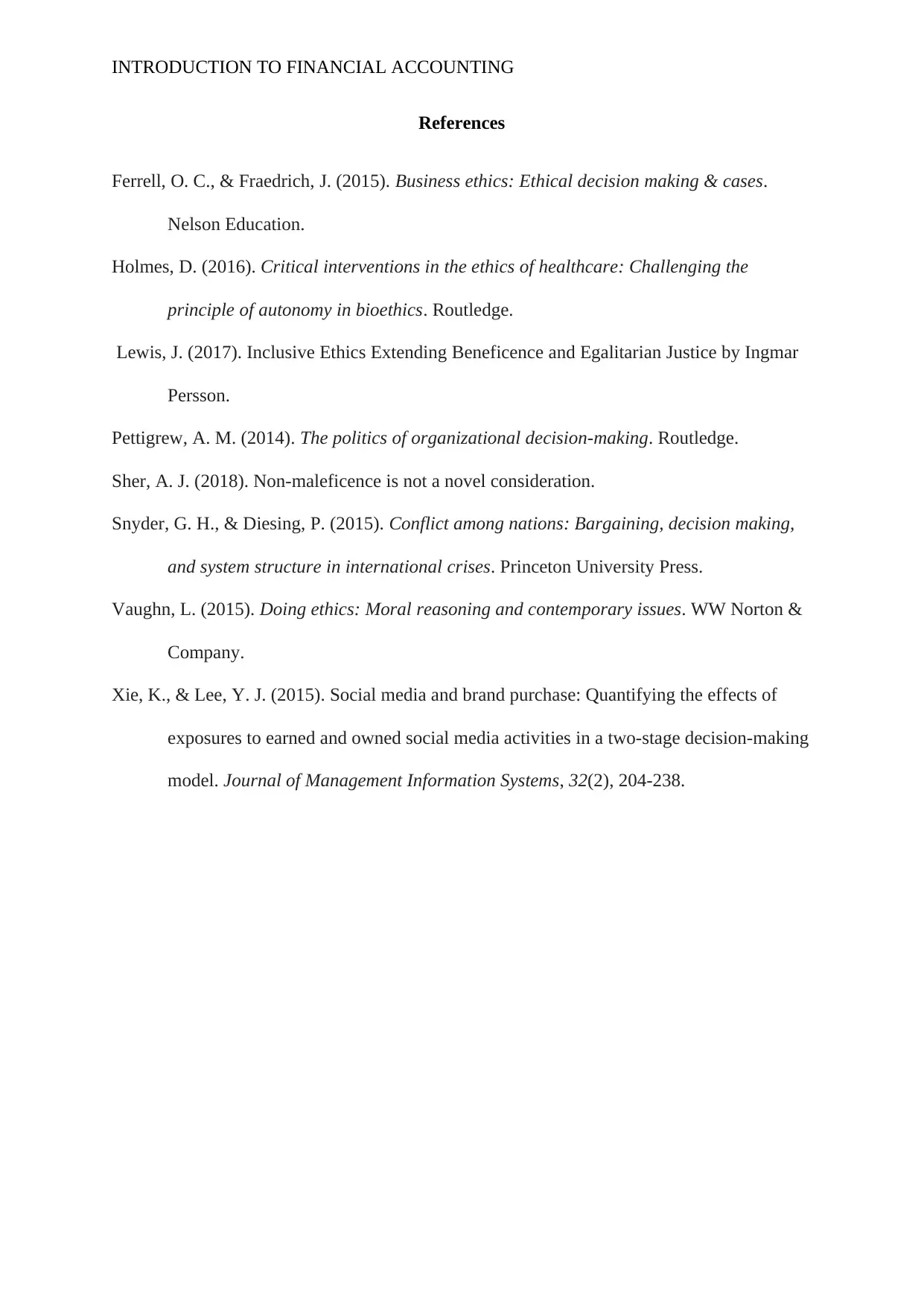
INTRODUCTION TO FINANCIAL ACCOUNTING
References
Ferrell, O. C., & Fraedrich, J. (2015). Business ethics: Ethical decision making & cases.
Nelson Education.
Holmes, D. (2016). Critical interventions in the ethics of healthcare: Challenging the
principle of autonomy in bioethics. Routledge.
Lewis, J. (2017). Inclusive Ethics Extending Beneficence and Egalitarian Justice by Ingmar
Persson.
Pettigrew, A. M. (2014). The politics of organizational decision-making. Routledge.
Sher, A. J. (2018). Non-maleficence is not a novel consideration.
Snyder, G. H., & Diesing, P. (2015). Conflict among nations: Bargaining, decision making,
and system structure in international crises. Princeton University Press.
Vaughn, L. (2015). Doing ethics: Moral reasoning and contemporary issues. WW Norton &
Company.
Xie, K., & Lee, Y. J. (2015). Social media and brand purchase: Quantifying the effects of
exposures to earned and owned social media activities in a two-stage decision-making
model. Journal of Management Information Systems, 32(2), 204-238.
References
Ferrell, O. C., & Fraedrich, J. (2015). Business ethics: Ethical decision making & cases.
Nelson Education.
Holmes, D. (2016). Critical interventions in the ethics of healthcare: Challenging the
principle of autonomy in bioethics. Routledge.
Lewis, J. (2017). Inclusive Ethics Extending Beneficence and Egalitarian Justice by Ingmar
Persson.
Pettigrew, A. M. (2014). The politics of organizational decision-making. Routledge.
Sher, A. J. (2018). Non-maleficence is not a novel consideration.
Snyder, G. H., & Diesing, P. (2015). Conflict among nations: Bargaining, decision making,
and system structure in international crises. Princeton University Press.
Vaughn, L. (2015). Doing ethics: Moral reasoning and contemporary issues. WW Norton &
Company.
Xie, K., & Lee, Y. J. (2015). Social media and brand purchase: Quantifying the effects of
exposures to earned and owned social media activities in a two-stage decision-making
model. Journal of Management Information Systems, 32(2), 204-238.
⊘ This is a preview!⊘
Do you want full access?
Subscribe today to unlock all pages.

Trusted by 1+ million students worldwide
1 out of 6
Related Documents
Your All-in-One AI-Powered Toolkit for Academic Success.
+13062052269
info@desklib.com
Available 24*7 on WhatsApp / Email
![[object Object]](/_next/static/media/star-bottom.7253800d.svg)
Unlock your academic potential
Copyright © 2020–2025 A2Z Services. All Rights Reserved. Developed and managed by ZUCOL.





